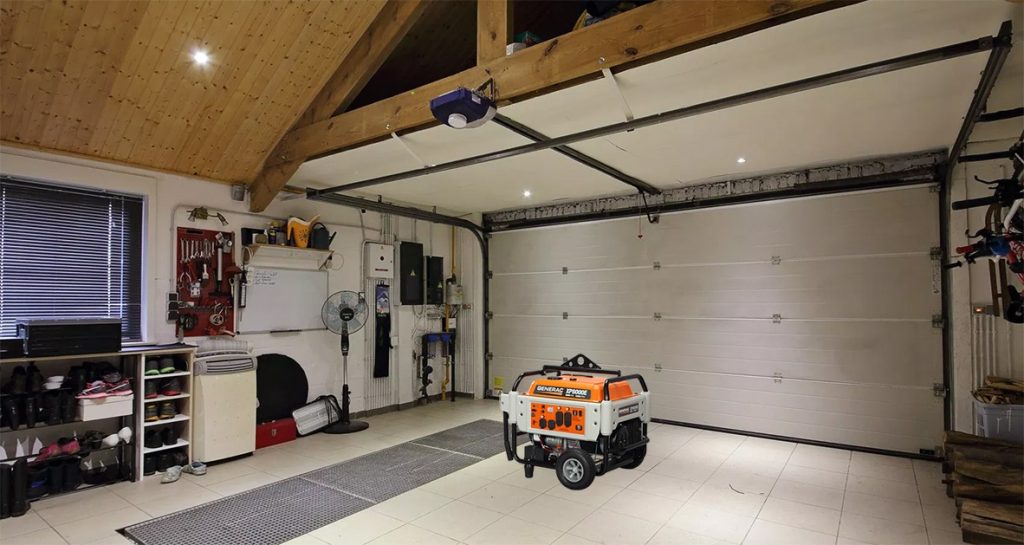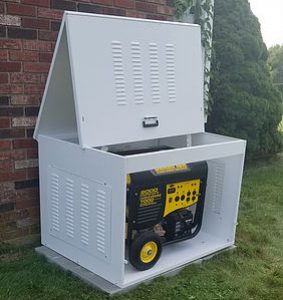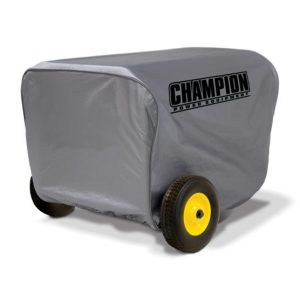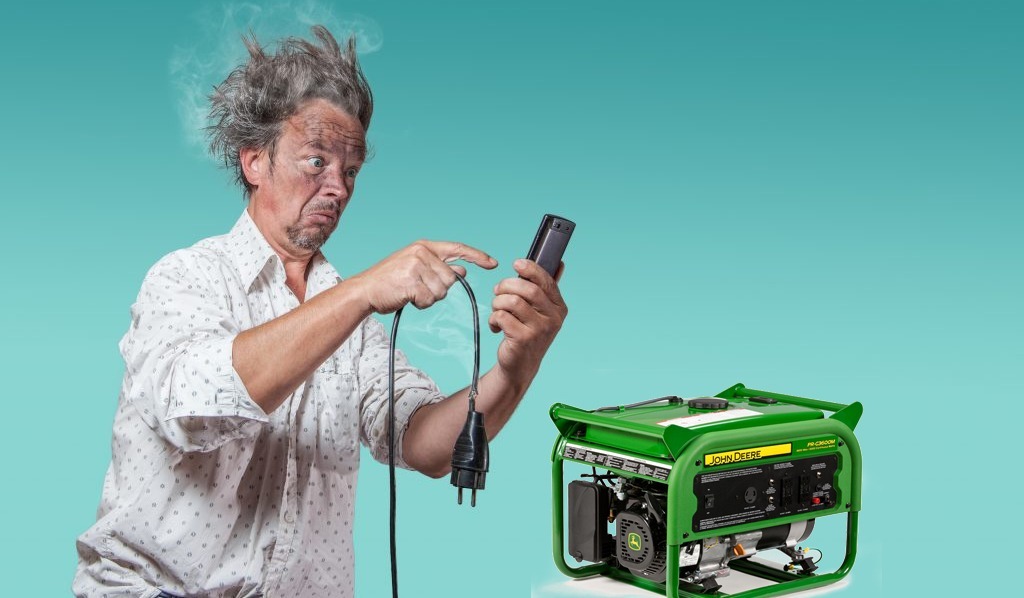How to Run a Portable Generator Safely Whether in Rain, Snow or Wet Weather
Last Updated on March 10, 2025

It might just be that you are one of those people who feel that they have no option but to use a portable generator in wet weather. If not, have you considered what happens when you go tailgating or camping in an RV Park or race track and suddenly power goes off in the middle of the party? Will you be ready to run your portable or inverter generator in such wet weather? Of course this would be inadvisable. In some situations, it can even be disastrous.
Obviously, most people know that it is quite dangerous to use a portable generator inside a garage or very near an open window. Ideally, as manufacturers caution, a generator should always be located at least 10 feet from your home. This limits the risk of CO poisoning. As Joseph Mohorovic, an expert on the matter recently said, it is never safe to run a generator in the garage, regardless of whether the door is left open or not. The dangers of CO poisoning remains real in such a situation.
Fatal Electric Shock
 The question comes, why isn’t it advisable to use a portable generator in wet weather? The reason is simple: there is danger of water getting into the outlets. Indeed, there is real risk of damaging the generator if the electrical panel becomes wet. What is worse, the risk of electrocution is high.
The question comes, why isn’t it advisable to use a portable generator in wet weather? The reason is simple: there is danger of water getting into the outlets. Indeed, there is real risk of damaging the generator if the electrical panel becomes wet. What is worse, the risk of electrocution is high.
Mostly, many portable generators usually have what is called the GFCI. This means outlets of the ground fault circuit interrupt. Immediately these outlets get wet, they automatically shut themselves off. Of course, anyone going near the generator at such a time would be inviting instant electrocution.
GFCI (ground fault circuit interrupter)
 As the Honda product manual explicitly states, a portable generator, small as it is, can actually produce enough power to cause serious shock and, at worst, electrocution. It is very important to check all electrical components found on the control panel before using it. And it is especially wise to check this and the GFCI if the portable generator is not protected from adverse weather and is stored outdoors.
As the Honda product manual explicitly states, a portable generator, small as it is, can actually produce enough power to cause serious shock and, at worst, electrocution. It is very important to check all electrical components found on the control panel before using it. And it is especially wise to check this and the GFCI if the portable generator is not protected from adverse weather and is stored outdoors.
Moreover, trying to use the generator or any other electrical appliance in the snow, rain, near a water pool or sprinkler system can be very dangerous. Even if only your hands are wet, this could lead to instant electrocution. For this reason, it is always important to keep the generator as dry as possible. How then can you stay safe? Consider the 10 safety tips outlined below.
10 Tips for using a portable generator safely
Interestingly, trends show that, regardless of many warnings published by manufacturers, many users of generators disregard the safety warnings, leading to frequent injuries and deaths. The tips below can help you avoid such needless disasters and help save lives.
Keep way from generator damage and electrocution
Never run your generator in wet weather, unless you use a generator tent. Remember that electricity and water do not mix. When they do, the result is generator damage and possible electrocution of people. This happens due to water getting into electrical panel or outlets, causing short circuit to the frame.
It is especially true because most portable generators are grounded to their frames. This situation causes a static charge on the metallic sections. Death may be caused when there is a plugging in or out of a generator that is wet. This results into a powerful electric arc that can cause injury or death.
Never run a generator in a garage or indoors
It does not matter even if you left the doors open. Never do this. The consequences can be disastrous. It can lead to CO poisoning. Whenever you want to use the generator, go outdoors, at least 20 feet away from the nearest building. Remember that carbon monoxide is an instant killer. Making it more lethal, carbon monoxide is colorless, odorless and weighs more than air. For this reason, this killer gas has the ability to collect and build up quickly anywhere.

As noted, merely opening the garage door is no guarantee that CO will go out of garage. To the contrary, if the wind is actually blowing inward, this can make the lethal gas get right into your home. It will simply diffuse in through openings in doors or window seals. Even if the garage or shed were somewhat detached, you should remember that CO can linger around for many hours.
Lethal fumes
To illustrate, you may enter the garage several hours later to refuel the engine. Even then, you can still be overcome by the lethal fumes since it would still be present in large quantities regardless of passage of time. Interestingly, research shows that portable generator CO levels are 1500 times higher than present-day vehicle engines! It is, therefore, good advice to always keep the generator outdoors and faraway from habitable structures.
In fact, most open-framed generators emit heat on all its four corners. Moreover, enclosing the generator actually reduces its lifespan since the machine always runs too hot. Avoid using either flash-flammable materials or those that can melt. This can easily result in serious injury or fire.
Always use only one hand whenever you touch the generator
This is advisable since it helps to avoid the creation of a circuit through the body. Ensure that, while attending to the generator, you always use rubber-soled shoes. Certainly, never help electric currents move into wrong places. Our body is such a place. Whenever you go near a running generator, always touch the metallic surfaces using just one hand. As noted, wear rubber- soled shoes. This is especially true if the ground happens to be wet. As a rule, electricity always flows through the path of least resistance. If you aren’t careful, this can be your body!
Never use the generator in hurricane or adverse weather:
We all know what damage cyclones, hurricanes or tornadoes can do. Especially when the speed is between 60-70 mps, it can be devastating. At such times, heavy objects can be carried away. If you attempt to use your generator in such adverse conditions, the result can be disastrous. For one, the generator may be swinging about from one side to the other and might even be carried away. Why not wait until the wind has subsided before you try to do this? It will not cost you much in comparison with the possible damage when trying to run the machine in adverse weather.
Avoid standing over the hot muffler place when refueling:
It is good to know which part of the gasoline actually ignites the fumes; these are the small droplets from the gasoline. They get mixed with air and result in fumes. Before refueling, always allow the muffler at least 10 minutes to cool. Of course, never attempt to stand on the hot muffler side while refueling. This can be fatally dangerous.
Avoid fuel clogging
Ensure that you always shut off the fuel valve. Always run the generator until it automatically stalls. This ensures that the fuel does not clog the fuel injectors or carburetor. In case you want to store the generator for long, use fresh fuel. You should also use a fuel stabilizer. Remember that, every time you need to use your generator, you will want it to start immediately, without hassles.
Most of the time, the reason why the generator refuses to start is due to fuel issues. Really, the gasoline easily gums up the engine structure when it stays for a long time unused. Always run your generator completely dry so that it is rid of all gasoline before storage.

Since this may not actually be practical, try to turn off the fuel supply valve. In this manner, you can let the fuel injectors or carburetor run dry. After this, you will know that the generator is dry when it automatically stalls. You can then add a fuel stabilizer in the tank. Do not forget to try and run the generator at least once in every three months. These steps can help you reduce any generator start-up issues in future.
Turn off main switch prior to starting your generator
It is very important to do this. Once the generator starts and goes into idle mode, you can now turn on the main switch. Most generators that have come into the market recently do have a main on/off switch. Before you ever start or stop the generator, always ensure the switch is off. This should also be the case whenever you plug in or unplug the cords that are found at the generator electric panel.
The benefit of doing this is that the generator will always be ready to take the load whilst also ensuring your own safety. Ensure that all your electrical appliances are protected from damage whenever the generator is starting or shutting down. It is good to be cautious because the electricity created during such times may have amperage or voltage spikes. These can be dangerous, hence the need to be cautious.
Avoid floodwaters
At all times, avoid placing the generator in an area prone to flooding. Of course, this is a matter of common sense. As long as the water levels rise during floods, it places your own safety in danger while also putting the machine in danger of damage.
Use a transfer switch for back up:
A transfer switch helps gets electricity from the generator by isolating the necessary circuits. This ensures that power does not back feed onto its immediate source, that is, the power lines. If electricity back feeds, it can mean instant death to line workers. The transfer switch also ensures the generator isn’t overloaded and therefore works effectively.
Steel Enclosures
 One great way to run your generator in safe condition is by using steel enclosures. So as to make sure your generator does not overheat, you can use louvered openings generously. However, only some generators are matched up to this. Not all machines can fit into such enclosures. Remember that good steel enclosures should be professionally installed. A fitting pad for mounting the enclosure is also important.
One great way to run your generator in safe condition is by using steel enclosures. So as to make sure your generator does not overheat, you can use louvered openings generously. However, only some generators are matched up to this. Not all machines can fit into such enclosures. Remember that good steel enclosures should be professionally installed. A fitting pad for mounting the enclosure is also important.
Plastic Shed
 Remember that, if you have a larger portable generator, then you will need relatively costly retrofit kits. This is a specialized plastic shed. The initial price for one of these is usually around $400. They often come with an additional shelter that costs some $949, starting price. It is good to remember that the manufacturers warn against enclosing portable generators for reasons discussed above. It is, therefore, important to be wary against these types of items.
Remember that, if you have a larger portable generator, then you will need relatively costly retrofit kits. This is a specialized plastic shed. The initial price for one of these is usually around $400. They often come with an additional shelter that costs some $949, starting price. It is good to remember that the manufacturers warn against enclosing portable generators for reasons discussed above. It is, therefore, important to be wary against these types of items.
Pop-Up Canopy
 Pop-up canopies are not the most viable considerations when it comes to protection of your generator. For instance, they cannot protect the sensitive outlets from blown-aside rain. They are also easily damaged by winds that go at more than 20mph. Additionally, they are also difficult to anchor especially in driveways. They cost from around $75 to over $300 depending on frame and fabric quality desired.
Pop-up canopies are not the most viable considerations when it comes to protection of your generator. For instance, they cannot protect the sensitive outlets from blown-aside rain. They are also easily damaged by winds that go at more than 20mph. Additionally, they are also difficult to anchor especially in driveways. They cost from around $75 to over $300 depending on frame and fabric quality desired.
Generator Covers:
 As already stated, it is generally unsafe to use generators in the rain, snow or during wet weather. Is there a way to get round this? Happily, yes. You can buy a good quality generator cover. If you get a good cover, it helps protect the generator from elements. At the same time, you can still operate it safely. It can act to waterproof and protect places in the machine where you do not want to become wet.
As already stated, it is generally unsafe to use generators in the rain, snow or during wet weather. Is there a way to get round this? Happily, yes. You can buy a good quality generator cover. If you get a good cover, it helps protect the generator from elements. At the same time, you can still operate it safely. It can act to waterproof and protect places in the machine where you do not want to become wet.
Good enough, the special cover will still let the generator be portable. You can easily and quickly install it or even transport it to various places. Some of these covers even promote natural cooling. A few are suitable during blizzard or hurricane although, as noted, it’s dangerous to do so in adverse weather.
The Elements
Ensure that the most sensitive sections of the machine ae 100%well protected. These include the outlets. Make sure there is some airflow to reduce overheating. Ask yourself, can my new enclosure handle strong wind and the elements? Is it portable? If the answer is yes, then you are safe.
In the end, though, one question comes: How can I build this kind of enclosure for my machine? Exactly what materials do I need for such a project?
DIY Enclosure for Portable Generator
Project Needs:
You need a few things to build a good enclosure for your generator. These include the following 9 items:
- Measuring tape
- Aluminum sheet
- Cheap louvered vents
- Carpentry pencil
- Jigsaw
- ½ and ¼ screws for machine
- Sealant caulk
- Railing bars
- Some plywood
After you have assembled all the items required, it’s now time to start the actual construction of your generator enclosure. How do you go about it? Simply follow these steps methodically.
-
Design enclosure:
The first thing to do is to have a sketch of the kind of enclosure you want to build, its shape, size and structure. In this sketch, ensure you pinpoint the features exactly as you want it. This will also help you know the kind of material that you require and the quantity. Remember, the enclosure must not only keep out the rain, it must also allow some air to reach the engine.
At the same time, the generator heat and exhaust air should get a leeway to exit. This keeps the machine functioning efficiently and also takes care of safety issues. In the sketch, mark out the positions of such important elements as the monitoring system, cooling fan, vents, the exhaust and other cooling features. Allow 2 to 3 inches of space to separate the generator baffle box from the generator.
-
Top panel
Use a saw to cut off the plywood. This makes it align with the overall dimensions at the total top. It also aligns with all other allowances already put in place. Afterwards, the front and side panels will get fixed to the top panel. You now need to measure and chop off the 20.5 inch railing bars. Ensure their dimensions align with the top panel measurements. For the width requirements, simply cut two more of these. However, make them a bit shorter. Next, use the 1 inch desk screws to attach the railing bars to top panel. The latter will further help you attach the rest of the panels to align with the top.
-
Front and side
What is the front panel? It is the panel that is positioned at the point around the engine air take. Eventually, the back panel will be built on its own in another step of this process. Interestingly, both the front and side panels are constructed in a similar way. Measuring with front and side dimensions, you now need to cut off three plywood pieces. After this, measure the louvered events to their proper size. Then mark the outline that is rectangular in shape, using the carpentry pencil.
Remember that the vents will be very important in allowing circulation of air inside the closure when the generator is running. Now, cut the slots using the jigsaw. You can also make holes in the outline and cut it, using the dremel. Ensure you cut it neatly, in a straight line, for good appearance. Finally, fix the vents to side panels using the ½ inch screws.
-
Building the back panel
This is usually made a bit differently from the others. Intricacies and complexities of the exhaust system demands for this. Make sure you do not compromise on the functionality just to keep out the rain. Ensure that the exhaust release has absolutely no obstruction. Accumulation of exhaust fumes can lead to generator damage.
Remember that the back panel must be a bit less than half the measurement of the front section. The remaining space is usually occupied by the aluminum flashing sheet. The sheet should be just a bit larger than the back panel wood.
-
Fix the sheets
At this juncture, use the ¼ inch machine screws to fix the aluminum sheet to the panel at the back. The larger sheet functions as canopy, protecting the generator from damage. It can also be bent to allow exhaust gases to escape.
-
Assemble the panels
How do you assemble the panels? Follow these simple suggestions:
- Use the 1 inch desk screws to fix four of the panels to the rail bars. Put all the edges at right angles. Use the L-shaped brackets to do this. For every corner, you need to use two of these brackets.
- Seal the sealant caulk for the porous edges. You may use a carpenter’s glue. This can, however, be too tight should you need to adjust the design later. At this point, the enclosure is ready to be tried.
- Wrap bungee cords all around the generator. This prevents the enclosure from getting blown away whenever the wind is very strong.
- Modify the baffle box. The design already created is just like a cover placed over the generator. Add a pallet to the bottom panel. While doing this, make provision for the wheels of the generator.
Presumably, the generator is now completely covered. You may add extra features to the baffle box, later, as you wish. These can include an attic vent, exhaust system, fiberglass installation, cooling fan, a temperature regulator and insulation.
Conclusion:
Why should you allow snow, rain, or bad weather to prevent you from enjoying generator convenience anytime you are camping remotely? Just build a good enclosure for your portable generator, ensuring it can alternately function as generator baffle box. If at all good for you, make sure the enclosure also allows you to monitor the temperature while limiting noise levels. Make good use of the suggestions above to continue enjoying the exciting generator experience come rain, sunshine or bad weather. Do you have further ideas on how this can be done even better? Feel free to share such tips with us in this space.
Contents
- 10 Tips for using a portable generator safely
- Keep way from generator damage and electrocution
- Never run a generator in a garage or indoors
- Always use only one hand whenever you touch the generator
- Never use the generator in hurricane or adverse weather:
- Avoid standing over the hot muffler place when refueling:
- Avoid fuel clogging
- Turn off main switch prior to starting your generator
- Avoid floodwaters
- Use a transfer switch for back up:
- Steel Enclosures
- Plastic Shed
- Pop-Up Canopy
- Generator Covers:
- DIY Enclosure for Portable Generator

